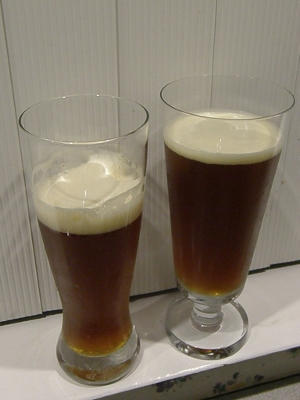Start Rolling Bottling, Labeling Tasting
November 29, 2009
After waiting for a few weeks I put one of the champagne bottles filled with Dino Brew in the refrigerator and left for work. By now the yeast had had a chance to act on the priming sugar and generate some bubbles; I'd helped it along by moving the cases of beer into the kitchen on sunny days to let them get some warmth from the sunshine streaming in over the counter. The bottles stayed in the cases - it was the warmth that the yeast needed to get livened up, not sunlight. Direct light on the bottles is known to be a bad thing for beer, and that's why many beer bottles are made with a deep brown glass.
It was dark when I returned from the store - it was brisk with a clear moonless sky, and Orion stood above the horizon in the southeast. Back at the house the brew was chilled and ready to go, so I pulled out three glasses and popped the cap off the bottle. There was a faint hiss, no popping noise, and the brew didn't geyser up. Was it going to be a disappointingly flat beverage like the distressingly sweet British brew call Old Peculiar? I poured the brew a bit aggressively into the first glass and it began to foam, building up a head in a hurry. When the glass was nearly full I tipped the bottle up slightly to stop the pour, but kept it horizontal until the mouth of the bottle was over the second glass (with home brew you should pour out the entire bottle without tipping it upright to keep the yeast residue in the bottom from getting stirred up). I poured more slowly into the second glass; initially it was foamless, but shortly it began to develop a head. The yeast didn't show up in the neck of the bottle until the very end. There was only a little less than an ounce left in the bottle; the yeast had clung to the bottom just the way a brewing yeast should so the glasses of brew were bright and clear.
 The head on the first glass was pretty impressive so I ran off to get the camera, but by the time I captured the image the suds had subsided a bit. The head in the other glass, the one I'd poured more slowly, seemed to be more solid and durable. Gotta pour slower next time!
The head on the first glass was pretty impressive so I ran off to get the camera, but by the time I captured the image the suds had subsided a bit. The head in the other glass, the one I'd poured more slowly, seemed to be more solid and durable. Gotta pour slower next time!
So, I picked up one of the glasses and had a swig. The taste of the hops I'd added late in the fermentation was there, the body was full with a malty tang, there was sufficient carbonation - it was a drinkable ale. It isn't a knock-your-socks-off prize-winner, but on the other hand it didn't have objectionable characteristics that would make drinking it a chore. I can assure you that decades ago I brewed swill so objectionable that I left it to cool its heels under the house for the better part of a year, and only brought it out at the insistence of a crew of Cal-Tech grads in crampons that had come over to aerate the lawn using mountaineering techniques. That brew was actually a barley wine, quite potent, but nobody stomped on a neighbor during the melee in the yard and the turf was aerated without bloodshed.
The Dino Brew does have a kick but I can't say precisely what percent alcohol it is; the way you can tell is to test the specific gravity just after the wort is cooled, then again just before bottling the brew. The difference between the two readings will tell you how much sugar was converted into alcohol, I think. Next time I'll be more scientific. Roughly, based on a subjective unpatented buzz-factor, I think the strength is around 6 or 7 percent.
There have been a few other reviews of the ale that have filtered back to me - so far nobody has been hospitalized or gone blind from drinking Dino Brew, so maybe I should go commercial, eh?

